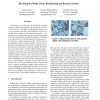Free Online Productivity Tools
i2Speak
i2Symbol
i2OCR
iTex2Img
iWeb2Print
iWeb2Shot
i2Type
iPdf2Split
iPdf2Merge
i2Bopomofo
i2Arabic
i2Style
i2Image
i2PDF
iLatex2Rtf
Sci2ools
PG
2003
IEEE
2003
IEEE
Breaking the Walls: Scene Partitioning and Portal Creation
In this paper we revisit the cells-and-portals visibility methods, originally developed for the special case of architectural interiors. We define an effectiveness measure for a cells-and-portals partition, and introduce a two-pass algorithm that computes a cells-and-portals partition. The algorithm uses a simple heuristic that creates short portals as a mean for generating an effective partition. The input to the algorithm is a set of half edges in 2D, that can be extracted from a complex polygonal model. The first pass of the algorithm creates an initial partition, which is then refined by the second pass. We show that our method creates a partition that is more effective than the common BSP partition, even when the latter is further refined with the application of our second pass. Our cells-and-portals algorithm is designed to deal with arbitrarily oriented walls. The algorithm also supports outdoor scenes, where the vertical walls of the buildings serve as occluders and portal...
| Added | 05 Jul 2010 |
| Updated | 05 Jul 2010 |
| Type | Conference |
| Year | 2003 |
| Where | PG |
| Authors | Alon Lerner, Yiorgos Chrysanthou, Daniel Cohen-Or |
Comments (0)

